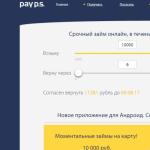
Calculator calculating material benefits by loan. Treatment of NDFL material benefits from savings percentage for the use of borrowed (credit) means. Who pays NDFL
Interestable loans are fairly common ways to transfer a certain amount of money in debt. They can be carried out between individuals or by different companies. At the same time, an appropriate agreement is created, which is a guarantee of refund. Take the money with this method quite easy. However, it should be determined by the material benefit on an interest-free loan that is calculated simply enough.
The fact is that even on an interest-free loan a bet can be installed, it takes into account the inflation rate usually. But most often the interest rate below the refinancing rate is about 2/3. In this case, the borrower has a benefit represented by unpaid percentages for the use of borrowed funds. This income Taxation is subject to taxation, so it is important to correctly calculate the material benefit, determine the amount of the tax, as well as pay to its tax services.
It appears as a result of the preparation of the contract between those who give money in debt and the borrower. In this case, the amount that is prescribed in this document is issued either at all without accrual interest or on preferential terms. In this case, the borrower appears saving on unpaid percentages. From the correctly calculated amount, the NDFL is paid.
The fact is that some companies have relatively recently used in this way to issue wages or transferring money to their relatives, which ensured care from official tax payments. Therefore, the state has established the need to pay small fees with such loans.
Accordingly, the benefit from the contract occurs in the following cases:
- there is no accrual of any percentage on borrowed funds;
- installed minimum bidnot exceeding 2/3 refinancing rates.
If an area of \u200b\u200binterest-free loan is drawn up, expressed in any currency, then the profit will be obtained by a borrower when the rate is set, not exceeding 9%.
It is important to note that the benefit occurs only in the case of the subject matter of the subject of the contract, and it cannot decide with the property loan.
Are often situations in which, at the expense of taxation, interest-free loan becomes inappropriate, so the design is more interesting for the borrower standard loan in a banking institution. In order not to have no such situations, it is necessary to know exactly how the indicator is calculated.
To calculate the material benefit on an interest-free loan, a standard formula is applied. It occurs from the day when interest is made under the contract in accordance with preferential conditions. If a contract is concluded according to which there are no interest, then the benefit is usually formed on the day of debt repayment. However, there is no such rigid concept in the NC. Therefore, one of the following days is selected:

At the same time, it is important for each option to correctly settle, since there are features of any method. The most often used formula for which the calculation is carried out in accordance with full repayment loan. For this, it is important to know what the refinancing rate is on a specific day when the benefit is considered. If partial payments are made, then for each application money A separate indicator is calculated.
MV \u003d refinancing rate, which is the limit * loan amount / 365 *.
Important! If the loan repayment is carried out on the last day of lending, then the benefit is formed only in that month when the return is made, therefore is charged on the full amount of borrowed funds.
As determined by the benefit under prefidence
It is important to determine the benefits not only for a fully interest-free loan, but also for a loan representing on preferential terms. In this case, it is important that the rate set by such a loan does not exceed 2/3 of the refinancing rates. The entire calculation is carried out in almost the same way as described above, but a slightly modified formula is used:
MV \u003d (refinancing rate, which is the limit - bid rate) * loan amount / 365 * credit money in the days.
Thus, it is very simple to calculate this indicator, both when using an interest-free loan and in privileged lending. 
Features of calculation for loans issued in currency
It is often situations when cash is issued in debt without accrual interest or with a small bet not in rubles, but in any currency. In the case when the bet is set on such a loan and does not exceed 9%, then the borrower has a benefit from which the tax is calculated. His borrower must pay the state. The legislation clearly indicates that the income received in foreign currencyBe sure to recalculate in rubles at the rate of the day when a profit was received. In this situation, income receives the debtor on that day when it is completely or partially extinguished by the loan.
The calculation is carried out by using a simple formula:
MV \u003d loan amount * The course of a particular currency in which a loan was issued, and on the date, when the loan was repaid * (9% - the percentage of the loan) / 365 * The term during which the borrower use credit funds.
If there was an interest-free agreement at all, the indicator will be considered a bit modified formula:
MV \u003d Loan amount * The course of a specific currency in which a loan was issued, and on that date, when the loan was repaid * 9% / 365 * the period for which period the borrower to use credit funds during which period.
Thus, after obtaining the necessary benefit, the amount of the tax can be determined, it is 35% of this indicator.
The legislation states that material benefits can only be calculated in the event that money is issued. If they are used to buy or erect residential real estate, as well as to acquire land plot, then such loans are not subject to taxation. 
However, the lender must submit a special document into the inspection, according to which it has the right to count on receiving deduction. The paper is formed in a special form approved at the legislative level, and is also transmitted to the tax authorities at mandatory. Without this document, it will not be possible to prove that the loan was not monetary, so tax inspectorate Calculates tax on the calculated material benefit.
Rules for calculating in a situation where the company is a company
As a lender, not only a private person can act, but also legal. Most often, different companies give out interest-free loan to their employees, and for this may not be accrued in interest or the rate is established, which is significantly lower bank interest. For this, the corresponding contract is also drawn up. The whole process occurs according to the following scheme:
- If the company issued a loan to a private person at a low rate, then the material benefit of an interest-free loan is calculated. After its calculation, it is important to calculate the tax, and it equals 35% of the benefit. Most often, such a tax is calculated by the organization itself - the lender, after which the desired amount of funds from the salary of the borrower employee will be deducted.
Upon receipt by a borrower of funds from the employer, the company automatically becomes its tax agent. In this case, it is obliged to independently calculate the material benefit of its employees who take money from the employer on preferential terms. From the calculated amount determines the size of NFFL, and the calculated cash is transferred to the budget.
- The benefit arises constantly when repaying the loan, according to which or preferential interest is accrued, or any rate is not installed at all. Payments can be monthly or unite. Often for one tax period, which is the calendar year, the borrower does not carry out any payments on the loan. Therefore, this year does not calculate the material benefit, since it is absent.
- The most often the company providing loans to its employees independently makes interest accrual, and also holds NDFLs, for which a certain amount of money is taken from the official wage of the employee. At the same time, the amount of the tax may not exceed half the income of the citizen.
- Since the employer acts as a tax agent of the borrower, he maintains records of all loans issued to each employee - for which a special tax register is used. This information is provided in the inspection within a certain period.
It is often provided with borrowed funds to legalities from other firms, and preferential conditions are used for this. For this, there are a corresponding interest-free loan agreement between organizations. At the same time, the company acting as a borrower may not pay tax, since it does not form any material benefit. 
This moment is clearly prescribed in the 25th chapter of the NC, since in this case all revenues are listed with the tax. These do not apply to the material benefit arising from obtaining an interest-free loan or loan with preferential conditions at which the rate is very low.
If a company is acting as a legal entity using in the process of work eNVD system, the tax is calculated depending on certain unchanged indicators, and the coefficients are established regional authorities. However, even in such a situation, it is impossible to use material benefits for calculating the tax.
The company acting as a lender, under legislation, is also not obliged to pay VAT when issuing borrowed funds to another organization. This is due to the fact that issued and returned money are not reflected as expenses or income.
If installed under the contract minimum interest, then the funds received by them belong to non-deactive income.
How NDFL is calculated
When there is a need to pay personal income tax with the material gain received, the following rules are taken into account:
- if the borrower is the tax resident of the Russian Federation, then the calculated amount is charged 35%;
- if it is not a tax resident, then 30% will be charged.
The tax is not charged if the borrowed funds are spent on the following purposes:

In order to prove target use Funds, the relevant documents transmitted to the lender are prepared. In this case, there is no need to pay tax.
Thus, it is quite simple to calculate the material benefit upon receipt of a preferential or interest-free loan. A borrower must pay tax, however, there are certain exceptions to which the target use of money belongs. In addition, if the contract is compiled between the two legal entities, they are also not obliged to pay taxes.
Everyone knows that the incomes of taxpayers are subject to tax on the income of individuals at a rate of 13% (for example, with wages, the employer holds NDFL 13%). However, many do not even suspect that sometimes taxes are paid not only from the received funds, but also from saved. For example, if you took interest-free credit or a loan for a low percentage (below the limit rate, which we will tell later), then according to the Tax Code you received an implicit income (by saving on credit percent) and should pay tax from this income.
This implicit income is called material benefit.
Example:Lugovoy S.V. He took an interest-free loan from his employer. From the moment of receipt of the loan from Lugovoy S.V. There is an income in the form of material benefits with which the tax will be held.
The material benefit arises when receiving loans (loans) under a low percentage, when purchasing goods (works, services) in individuals and organizations that are interdependent in relation to you, as well as when purchasing valuable papers At prices below market. As part of this article, we will consider only the material benefit derived from the savings for the use of borrowed funds, because This case is the most common.
The size of material benefit
Let's consider in what cases and in what size (upon receipt of a loan or loan) you may have income in the form of material benefits.
Material benefit occurs if the credit rate is below the limit rate equal to 2/3 from the refinancing rate. Currently, the refinancing rate is equal to the key bank's key rate - 9% (for mid-June 2017). Accordingly, the loan margin issued since May 2017 will be 6% (2/3 * 9%). Thus, if you now take a loan less than under 6% per annum, then you will have a material benefit with which the tax will be held.
Notes: From 2012 to 2015 The refinancing rate was equal to 8.25%. From January 1, 2016, the refinancing rate corresponds to the key rate of the Bank of Russia. Its value varied from 11 to 9.25%.
The limit rate for currency loans has not changed in 2017 and is still 9% (paragraphs 2 of paragraph 2 of Article 22 of the Tax Code of the Russian Federation).
The size of the material benefit is equal to the difference between the marginal rate and the bid according to the loan agreement multiplied by the amount of the loan and the loan period.
Material Benefit \u003d (limit rate - rate under the contract) x loan amount x (loan period in days / 365 days)
At the same time, the material benefit is calculated monthly during the entire lending period, and in its calculation it is necessary to take into account the refinancing rate, which operated on the last day of the month (sub. 1, paragraph 2 of Art. 212, sub. 7 p. 1 Art. 223 of the Tax RF ).
Example: On June 1, 2017, the Organization issued its employee Sidorenko A.E. Interestable loan in the amount of 500,000 rubles. The maximum rate for June 2017 is 6% (2/3 * 9%).
Accordingly, for June, the amount of material benefits will be: 6% * 500,000 rubles. * 30/365 (number of days in June)\u003d 2 466 rub.
Example:Bukina D.G. I took at work a loan under 5% per annum in the amount of 1,000,000 rubles on June 1, 2017. The maximum rate for June 2017 amounted to 6% (2/3 * 9%).
The material benefit for July is calculated as follows: (6% - 5%) * 1 000 000 * 30/365 (number of days in June) \u003d 822 rubles.
Example:Drozdov V.B. In June 2017, the employer issued a loan at a rate of 8% per annum in the amount of 350,000 rubles. The maximum rate for June 2017 amounted to 6% (2/3 * 9%). Since the bid under the loan agreement is greater than 2/3 from the refinancing rate, with Drozdov V.B. There will be no material benefit.
Taxation of material benefit
According to paragraph 2 of Art. 224 of the Tax Code of the Russian Federation, material benefit is subject to NDFL at a rate of 35%. By general rule The tax is obliged to keep the employer who has been taken by a loan or a loan (paragraph 1 of Art. 226 of the Tax Code of the Russian Federation).
Example:LLC Raduga provided Kosolapoma A.S. An interest-free loan and kept with its wages material benefit at a rate of 35%. At Kosolapoy A.S. No obligations arise to the tax inspection.
If the income in the form of material benefits is not received from the employer, or the employer did not reduce the tax, you must independently submit to the tax authority a 10-NDFL declaration and report on tax (PP. 4 of paragraph 1, paragraph 6 of Art. 228).
However, in 2016, the Tax Code made changes that simplified taxpayers the reporting process in cases where they themselves should pay the tax on material benefits (if the tax was not retained by the tax agent). Since 2016, it is no longer required to submit a declaration of 3-NDFL, you only need to wait for notifications from the tax authority and pay for the tax notice (clause 6 of Art. 228 of the Tax Code of the Russian Federation, part 8 of Art. 4 of the Law of December 29, 2015 N 396-FZ ). In addition, these changes have increased the payment period of tax until December 1 (3-NDFLs were until July 15).
Example:In January 2017, Baskakova O.P. I took a loan at your employer at a rate of 5% per annum. In a month she went out in maternity leaveAccordingly, the employer had no opportunity to keep material benefit from its wages. In 2018, Baskakova need to wait for notifications from the tax inspectorate and pay tax until December 1, 2018. Independently fill out the 3-NDFL Declaration for 2017 for the declaration of income received in the form of material benefits, Baskakova O.P. No need.
Provide a 3-NDFL Declaration to the Tax Inspectorate you need from January to April 30, 2016, pay tax until July 15, 2016.
When an entrepreneur who issued the loans to individuals should be held NDFL
When does the borrower have a material benefit?
In cases where IP issued an interest-free loan or percentage below 2/3 of the refinancing rate of the Central Bank of the Russian Federation.
Who needs to list the personal income tax with the material benefit to the budget - an entrepreneur or borrower?
An entrepreneur who issued the money to the physician. A businessman becomes a tax agent on personal income tax. Therefore, he needs to keep the tax from the borrower and transfer to the budget. The incidence of NDFL is equal to 35%.
How to determine the benefits of saving percentage?
To calculate material benefits, use the formula:
The refinancing rate from this year is equated to the key rate. Therefore, to calculate the benefits you need to use a key rate - 11%.
This formula is also suitable for interest, and for interest-free loans?
Yes, only if the loan is interest-free, instead of a loan rate, an entrepreneur needs to be put 0.
At what point is the IP to determine the material benefit and the amount of NDFL?
In 2016, the material benefit on loans expect on the last day of each month.
Since 2016, the material benefits of saving percentage should be relying on the last day of each month, while the borrower uses money. Until 2016, Matveygoda was considered on the day of payment of interest either when the interest-free loan is returned.
Example
Suppose if the entrepreneur on May 26, 2016 led to an employee 100,000 ₽ without percent.
In this case, the first time determine the benefit on May 31. The formula needs to substitute the amount of the loan - 100 000 ₽ and the term of use of the loan is 5 days (from 27 to 31 May).
Ndfl from it - 35.06 ₽:
As long as the loan period does not end and the Money does not return, should be determined every month MatveyGood.
According to interest-free loans issued in 2015, it is necessary to consider material benefits and pay personal income tax?
Yes, the material benefit for the use of the loan until 2016 was required to calculate on January 31, 2016. Specialists of the Ministry of Finance of Russia came to this opinion.
If, IP has not yet determined the benefit of 2015 on time to do now, in May?
It is necessary to calculate the tax from the Matvyegoda obtained by the borrower. However, the calculation for each month do separately, because the amount of benefits depends on the number of days in each month of use of money. Still list the penalty for the delay in NDFL1.
When do you need to hold and transfer a tax on material benefit to the budget?
Ndfl, calculated from Matvyegoda, hold with the nearest payment of money to the physician.
List the tax into the budget no longer than the next day.
What if NDFL is impossible to hold?
For example, when the borrower is not an employee of the entrepreneur. If the entrepreneur was unable to keep NDFL from Matveygoda, please inform it in the FTS. To do this, no later than March 1 of the next year, hand over the borrower to the tax inspectorate 2-NDFL with a sign of 2.
In the same period, you should send a message to the borrower on the inability to keep tax in arbitrary.
When an entrepreneur who received loans must be paid by NDFL
Let's now consider the return situation. The entrepreneur received a loan for a low percentage or without percent. Does he have a material benefit? It all depends on who the merchant took the money. If another entrepreneur or organization has, then arises. If an ordinary saline has, then the judges believe that in this case there is no benefit.
Why? If the entrepreneur received a loan from the individuality, Matveygoda does not arise and pay ndfl is not needed. Article 212 of the Tax Code of the Russian Federation is clearly spelled out when the benefit of saving percentage is formed. This happens when the lender is a firm or IP. Therefore, if the loan received from a citizen, then the benefit does not occur. And pay ndfl is not necessary.
If the entrepreneur switched to a special tax regime and does not pay NFFL, the benefit may occur?
If IP applies a shift or patent, then the benefit, taxable personal income, does not occur. Provided that IP funds used in business translated on UNVD or PSN. In order for the inspection does not have any questions, we advise you to prescribe the appointment of funds in the loan agreement.
Do Ip on USN may appear Matveygoda, taxable personal income tax?
Yes, the merchants on the USN are released from personal income on business income. MatveyGode does not apply to them.
And if the entrepreneur has a benefit, who must list the personal income tax: the IP or the party issued a loan?
The lender, it is he who is a tax agent on personal income tax. Therefore, the one who issued money holds and lists the tax in the budget.
If the lender was unable to keep NDFL from the entrepreneur, then the tax should pay independently?
Yes. In this case, the tax authorities will send a notification about the payment of NDFL. The tax that the lender could not hold in 2016, will have to pay in 2017. Deadline - December 1, 2017.
Go back to the benefit of 2018
In the editorial office of PP. 3 p. 1 Art. 223 of the Tax Code of the Russian Federation, which previously said, it was said that the date of the actual receipt of income upon receipt of income in the form of material benefits is defined as the day of payment by the taxpayer of interest on the funds received (credit) funds. Thus, if the organization issued interest-free loans (or at a low rate), then the actual date of receipt of income in the form of material benefits should be considered the corresponding date of return of borrowed funds.
In a commentible letter, the financrafts noted: if there was no earlier repayment of debt on an interest-free loan, income in the form of material benefits to be taxed by the income tax on individuals in these tax periods does not arise.
A similar explanation is represented in the letter of the Ministry of Finance of the Russian Federation No. 03-04-05 / 10113: If until 2018 the repayment of the interest-free loan debt was not produced, income in the form of material benefits to be taxed on income tax, in tax periods preceding the tax period 2018 years, does not arise.
According to paragraph 4 of Art. 226 of the Tax Code of the Russian Federation, the deduction of the tax of material benefits comes from any income of the taxpayer paid to him by the Tax Agent in monetary form.
If it is impossible for tax period To keep the tax agent at the taxpayer, the tax agent is obliged for no later than March 1, following the expired tax period, in which the relevant circumstances arose, in writing to the taxpayer and tax author At the place of its accounting on the inability to keep the tax, the amounts of income from which the tax is not retained and the sum of the inconspicuous tax (paragraph 5 of Art. 226 of the Tax Code of the Russian Federation).
In accordance with PP. 1 p. 1 Art. 212 Tax Code of the Russian Federation The Organization is obliged to calculate NFFLs with the material benefit derived from the savings percentage in providing a loan (including an interest-free) physical face:
If the loan rate, the amount of which is defined in rubles, less than 2/3 of the refinancing rate (key rate) of the Central Bank of the Russian Federation (PP. 1 of paragraph 2 of Art. 212 of the Tax Code of the Russian Federation);
If the loan rate, the sum of which is defined in foreign currency, less than 9% (PP. 2 of paragraph 2 of Art. 212 of the Tax Code of the Russian Federation).
Article 224 of the Tax Code of the Russian Federation established rates on NFFL. This article says:
If the borrower is the tax resident of the Russian Federation - at a rate of 35% (paragraph 2 of Art. 224 of the Tax Code of the Russian Federation);
If the borrower is not a tax resident of the Russian Federation - at a rate of 30% (paragraph 3 of Art. 224 of the Tax Code of the Russian Federation).
The amount of material benefits of a loan issued in rubles is calculated by the formula:
MV \u003d SZ X (2/3 x% of the Central Bank of the Russian Federation -%) / 365 (366) x DN., Where:
MV - the material benefit derived from the savings percentage;
SZ - loan amount;
% Of the Central Bank of the Russian Federation - the refinancing rate of the Central Bank of the Russian Federation, operating on the last day of the month;
The amount of material benefit on a loan issued in foreign currency is calculated by the formula:
MV \u003d SZ X (9% -%) / 365 (366) x DN., Where:
MV - material benefit from savings percentage;
SZ - loan amount;
% - interest rate on loan;
365 (366) - the number of days a year;
dN. - The number of days of use of the loan per month.
For clarity, we give an example of calculating the material benefit individualobtained from savings percentage, personal income tax with it, indicating specific dates for receiving income.
Example:
12/18/2017 The organization provided its employee a loan in the amount of 60,000 rubles. For a period of 3 months per bet 3% per annum. The employee is a tax resident.
Interest is paid at the same time when the loan is returned. On March 18, the employee returned the loan and paid interest in the amount of 447.54 rubles. (60,000 rubles. X 3% / 366 days. X 91 days). Let us calculate the personal income tax with the material benefit derived from the savings percentage of the loan issued.
So, the date of receipt of income from saving percentage is recognized as the last day of each month during the period on which borrowed (credit) funds were provided in 2018, and in 2017 it is the date of repayment of the loan to the tax agent. Refinancing rate ( key rate) At the date of payment of interest - 11%.
In 2018, the material benefit received from savings percentage of loan will be:
On 31.01 - 223.6 rubles. (60,000 rubles. X (2/3 x 11% - 3%) / 366 days. X 31 days.). NDFL with the amount of material benefits - 78.26 rubles. (223.6 rubles x 35%);
On 29.02 - 209.18 rubles. (60 000 rubles. X (2/3 x 11% - 3%) / 366 days. X 29 days.). NDFL with the amount of material benefits - 73,21 rubles. (209.18 rubles. X 35%);
On 31.03 - 122,62 rubles. (60,000 rubles. X (2/3 x 11% - 3%) / 366 days. X 17 days.). Ndfl with the amount of material benefits - 42.92 rubles. (122,62 rubles. X 35%).
The material benefit received from savings percentage of loan for 2015 will be:
On 18.03 - 100,98 rubles. (60,000 rubles. X (2/3 x 11% - 3%) / 366 days. X 14 days). NDFL with the amount of material benefits - 35.34 rubles. (100,98 rubles. X 35%).
According to paragraph 4 and 6 of Art. 226 of the Tax Code of the Russian Federation, the Organization must keep NDFL with material benefits at the nearest payment of money to the borrower. As for the tax, it must be transferred to the budget no later than the day following the day when the money is paid.
According to Part 3 of Art. 7 of the Federal Law No. 212-ФЗ do not relate to the object of taxing by insurance premiums and other remunerations produced, in particular, within civil law agreements, the subject of which is the transition of property rights or other real rights rights (property rights).
Thus, the material benefit of the employee for using an interest-free loan received from the employer is not recognized by the object of taxing by insurance premiums.
These explanations are presented in the letter of the Ministry of Labor of the Russian Federation No. 17-4 / B-54.
Debt recovery 2018.
Residence permit 2018
Extrabudgetary funds 2018.
Internal control 2018.
Temporary registration 2018.
Back | | Up
© 2009-2018 Financial Management Center. All rights reserved. Publication of materials
it is permitted with the obligatory indication of the link to the site.
Calculation of NDFL with material benefits
In Article.212 of the Tax Code of the Russian Federation, the types of material benefits are listed from which the tax on income of individuals. From January 1, 2005, this list has become a little less. NDFL is now not subject to the benefit obtained by credit card operations during the so-called interest-free period established in the contract. Such a change was made to the Tax Code of the Russian Federation Federal law dated December 30, 2004 N 212-FZ.
At the same time, the tax is still needed to pay if the employee:
- got a borrow from his organization and at the same time saved percentage;
- bought goods (works, services) from the enterprise, in relation to which it is an interdependent face;
- acquired securities.
In this article we will tell, in what cases accountants should count NDFLs with the material benefits of workers and how to do it optimally.
Who and when paying tax
As a general rule, the tax on material benefits is calculated and paying an individual, which was obtained. The fact is that the enterprise must perform the obligations of the tax agent if the income (paragraph 1 of article 226 of the Tax Code of the Russian Federation) is paying the physical person.
In the case of material advantage, the employee in the arms from the enterprise does not receive anything. It turns out, and the tax is not held from what.
However, the employee may assign an organization that issued to him the loan or selling securities, its authorized representative. To do this, it is necessary to arrange and assure the relevant power of attorney in the notary (paragraph 3 of Article 29 of the Tax Code of the Russian Federation). Of course, the organization may refuse the employee and do not take additional troubles.
The enterprise, which became an authorized representative of the employee, will independently calculate the tax on the material benefit and transfer it to the budget. Of course, at the same time NDFL can be held only from the funds that the organization will pay the employee, for example, from the salary.
According to the general rule of taxpayers, independently calculating and paying NDFLs must list it to the budget no later than July 15, following the period in which the income was obtained (paragraph 4 of article 228 of the Tax Code of the Russian Federation). True, in the Methodological recommendations on the payment of NDFL (order of MNS of Russia of April 14, 2004 N SAE-3-04 / [Email Protected]) The tax authorities demanded that the authorized representatives transfer the tax calculated from the material benefit, the day after it was retained by the taxpayer. In fact, thereby the officials distributed on authorized representatives of the tax agents registered in Article 226 of the Tax Code of the Russian Federation.
Named Guidelines Last year were canceled. To find out the current position of the tax authorities, we contacted the FNS of Russia. Alas, but there still believe that, becoming an authorized representative of the borrower, the company automatically becomes a tax agent.
In fact, it is not. The authorized representative has nothing to do with tax agents and must act according to the same rules as the taxpayer himself who authorized him to pay tax. So, ndfl with material benefits, held, let's say, in January 2004, the authorized representative has the right to transfer to the budget no later than July 15, 2005.
If the tax authorities do not agree with this approach, it is not to prove that the authorized representative is not a tax agent, will have to be in court. If it succeeds, it is not worthwhile responsibility for the late payment of the organization's tax. After all, such responsibility is the employee. In particular, this is indicated in paragraph 7 of the Decisions of the Presidium of the Supreme Arbitration Court of the Russian Federation of February 28, 2001. N 5. To finish the same employee for the fact that the tax was listed in the budget only next year (but no later than July 15), the tax authorities will not be able to .
After all, the employee in relation to the tax agent itself is not, and, accordingly, the requirements of Article.226 of the Tax Code of the Russian Federation do not apply.
Material benefit on loans
According to paragraphs.1 of paragraph 2 of article 2212 of the Tax Code of the Russian Federation, the material benefit on borrowed funds is equal to the difference between the amount of interest accrued under the contract, and the value calculated on the basis of:
- 3/4 refinancing rates Central Bank The Russian Federation, established on the day, when the loan was received, - according to ruble loans;
- 9 percent per annum - on currency loans.
How to calculate material benefits
The size of the material benefit of loans is calculated on that day when the employee pays interest (paragraph 3 of paragraph 1 of Article 223 of the Tax Code of the Russian Federation). However, if the loan is issued, say, in 2005, and interest should be paid in the next - 2006, the tax on material benefits should be calculated not only on the day of payment of interest, but also on December 31, 2005. Also on the last day of the year it is necessary Calculate the NDFL with the material benefit on interest-free loans.
Example 1.. Vympel LLC on January 20, 2004 issued to his employee Mikhalkov V.M. loan for the purchase of a car - 500,000 rubles. under 7 percent per annum. Under the terms of the Mikhalkov contract, the debt must pay off January 20, 2005. On the same day, he is obliged to pay interest accrued for all the time of use of the loan.
The amount of interest accrued from January 21 to December 31, 2004 is inclusive (346 days), amounted to:
500 000 rub. x 7% x 346 days : 366 days. \u003d 33 087,43 rub.
The percentages calculated during this period on the basis of 3/4 refinancing rates of the Central Bank of the Russian Federation are equal (on the day of obtaining a loan, the refinancing rate established by the Bank of Russia was 14%):
500 000 rub. x 3/4 x 14% x 346 days : 366 days. \u003d 49 631,15 rub.
This means that the material benefit of the loan at the end of 2004 is 16,543,72 rubles. (49 631.15 - 33 087.43).
January 20, 2005, that is, that day, when Mikhalkov returned a loan and paid interest on him, it is necessary to calculate the material benefit for 20 days of January. She will be like this:
500 000 rub. x (3/4 x 14% - 7%) x 20 days. : 365 days. \u003d 958.90 rubles.
Since Mikhalkov took a loan money not to buy housing, his material benefit is subject to NDFL at a rate of 35 percent. The benefit tax received in 2004 will be:
16 543,72 rub. x 35% \u003d 5790 rubles.
958.90 rub. x 35% \u003d 336 rubles.
How to save on material benefit
Last years central bank RF periodically reduces refinancing rate. And, as we have already told, when calculating the material benefit, you need to use the bid that acted on the day of obtaining a loan. Moreover, the Bank of Russia may once again reduce the refinancing rate even before the loan maturity occurs. In this case, it is beneficial to terminate the old loan agreement and immediately conclude a new one on the same amount. The material benefit on a new contract will be calculated on a new reduced refinancing rate. This operation will make the greatest benefit if it takes it on that day from which the Central Bank of the Russian Federation reduced the bid. And so that the employee does not have to return a declared money on the cashier, the termination of the old contract and the conclusion of the new should be dated one day. Then the return and issuance of loans you will spend only on paper.
Example 2.. We use the terms of example 1. But suppose that Mikhalkov should pay off the loan on June 20, 2005, and from March 1, the refinancing rate of the Central Bank decreased to 11 percent.
If Vympel and Mikhalkov LLC will not renew the loan agreement, the employee's material benefit from January 1 to June 20, 2005 inclusive (171 days) will be like this:
500 000 rub. X (3/4 x 14% - 7%) x 171 days. : 365 days. \u003d 8198.63 rub.
Now let's say that, according to an additional agreement, the loan agreement was repaid on March 1, 2005. On the same day, Mikhalkov again lent at Vympel LLC 500,000 rubles. Under 7 percent of the annual until June 20, 2005, then the material benefit for the period from January 1 to March 1, 2005 inclusive (60 days) will be:
500 000 rub. x (3/4 x 14% - 7%) x 60 days. : 365 days. \u003d 2876.71 rub.
500 000 rub. X (3/4 x 11% - 7%) x 111 days. : 365 days. \u003d 1900,68 rub.
The total amount of material benefit on two treaties in 2005 will be 4777.39 rubles. (2876.71 + 1900.68). Thus, rebooting a loan agreement on that day when the refinancing rate decreased, Mikhalkov will reduce its material benefit by 3421.24 rubles. (8198.63 - 4777,39). And the amount of NDFL will be less than 1197 rubles. (3421.24 rubles. X 35%).
If the company sold goods to the employee
Often enterprises sell goods to their employees at low prices. And as we have already told, the tax on material benefits should be paid if the purchase and sale of goods took place between the so-called interdependent persons. Nevertheless, in this situation, neither the accountant nor the employee is not necessary to worry about the calculation of material benefits. Explain in detail.
The fact is that those cases where an individual is considered interdependent in relation to someone, are named in Article 20 of the Tax Code of the Russian Federation. There are only two such cases. First of all, two employees are considered to be, one of which is obeying the other on the official position. And secondly, interdependent spouses, relatives, adoptive parents and adopted, as well as trustees and swelling.
Thus, it does not follow from the Tax Code of the Russian Federation that the employee and the organization are automatically interdependent.
However, such a court can recognize them. This is indicated in paragraph 2 of Article 20 of the Tax Code of the Russian Federation. And in practice, sometimes it happens (see, for example, the Resolution of the FAS of the East-Siberian District of July 17, 2003 N A19-19140 / 02-24-F02-2097 / 03-C1). And the Presidium of the RF in the Russian Federation in Information letter Of March 17, 2003, N 71 indicated that the firm and its director were interdependent.
But it often happens that the courts come to a completely opposite conclusion. In particular, the FAS of the Ural District in the decision of November 27, 2003 N F09-4033 / 03-AK rejected the approval of the tax authorities that employees and the enterprise are interdependent.
Since the practice has developed contradiction, it turns out that the risk that the Court recognizes the interdependence of workers and the organization is. The consequences will be such. The tax authorities will receive the right to compare prices for which your company sold goods to employees, with prices for identical (homogeneous) products for which they are implemented under normal conditions not interdependent. And if the second indicator turns out to be higher than the first, the difference will be considered material advantage. The tax from it is paid at a rate of 13 percent (or 30, if the buyer is non-resident).
Comparing prices, the tax authorities will proceed from the definitions of identical and homogeneous goods, which are given in pp.6 and 7 of article 40 of the Tax Code of the Russian Federation, respectively. Another thing is that these definitions are pretty fuzzy, which often allows taxpayers in the courts to challenge the calculations of inspectors, providing judges that they compare prices on non-people or inhomogeneous goods. Exampleto that resolution of the FAS of the North-West District of November 22, 2004 N A56-5353 / 04.
But be that as it may, but the material benefits of goods, which the company sold its employees, will have to count on officials. It is not necessary to buy the buyer or accountant of the seller to do this, because, as we have already said, initially they will proceed from the fact that the employee in relation to the company is not interdependent. If the tax inspection of other opinions on this score, then it will have to prove it in court.
Another thing, if the item sells an individual entrepreneur to his employee. Then the employee will be obliged to calculate the material benefit on his own (or entrust it to an entrepreneur as his authorized representative). Indeed, in this case, the employee obeys the entrepreneur, and therefore, according to Article 20 of the Tax Code of the Russian Federation, they are considered interdependent persons.
Example 3.. An individual entrepreneur sold to his employee Makarov A. B. Refrigerator for 10 000 rubles. In the same month, the entrepreneur sold the buyers from the exactly the same refrigerators of 12,000 rubles. a piece. Thus, the material benefit of Makarov was:
12 000 rubles. - 10 000 rubles. \u003d 2000 rubles.
And tax on income of individuals with this benefit is:
2000 rubles. x 13% \u003d 260 rubles.
Buying securities
The material benefit on securities is the difference between the amount that the buyer - an individual paid for them, and the market price of papers, taking into account the limiting boundaries of the fluctuations of this price. It is spelled out in paragraph 4 of article 2212 of the Tax Code of the Russian Federation. The tax with such material benefits can pay both the buyer of securities and its authorized representative - an organization who sells these papers.
The procedure for determining the market price and the limit border of its oscillations was approved by the decision of the Federal Tax Service of Russia of December 24, 2003 N 03-52 / PS. Moreover, it is only about emission securities that rotate in the organized market. So, if the employee acquired from the paper, which in the same market does not appeal (for example, bills), then it does not have to talk about material benefit.
As for the securities applying to the organized market, their market prices can be found from the organizers of trading or on their websites on the Internet. The limit border of the oscillations of the market price of the Federal Tax Service of Russia set up 20 percent. Therefore, the material benefit is calculated by this formula:
MV \u003d (RC - RC x 20% - CPU) X KB,
where MV is material benefit; RC - market value secular; CPU - the price on which the security was purchased; KB - the number of purchased securities.
Please note: the market price of paper should be taken on that day when the deal was concluded. The material benefit from the purchase of securities is subject to NDFL at a rate of 13 percent. And if the securities bought a non-resident - at a rate of 30 percent.
Example 4.. OJSC "Crocus" sold its employee Nikonorov V.L. 1000 Own bonds at a price of 500 rubles. a piece. According to the organizer of the auction, the market price of one such action on the day, when the transaction was concluded between the Crocus and Nitonorov, amounted to 700 rubles.
Thus, the material benefit from buying bonds amounted to:
(700 rub / PC. - 700 rub / PC. X 20% - 500 rub / PC.) X 1000 pcs. \u003d 60 000 rub.
The tax with the material benefit of Nikonorov is:
60 000 rubles. x 13% \u003d 7800 rubles.
LDVontsov
Expert magazine "Glavbukh"
Since 2018, the procedure has changed the procedure for issuing personal income tax of material benefits for loans (PP.1 of paragraph 1 of Article 22 of the Tax Code of the Russian Federation (as amended, acts. From 01/01/2018)). Thus, the taxable benefit occurs under the observance of at least one of the conditions:
- the loan is obtained by the saline from the organization or the PI, with which it is in labor relations;
- the loan is obtained by a saline from an organization or IP, which are recognized with him with interdependent persons;
- savings percent actually is material help;
- savings percentage is actually a form of counter execution by the organization or IP commitment to the individual, incl. payment (remuneration) for the goods supplied to them (performed works, services rendered).
True, sometimes the material benefit is not subject to personal income tax, even contrary to the observance of at least one of the above-mentioned conditions.
When the borrower does not occur in any case the taxable personal income tax of the material benefit on loan
Material benefit is exempt from taxation when performing two requirements (PP. 1, 1 Article. 212 Tax Code of the Russian Federation):
- the loan agreement states that funds are provided to the borrower to buy concrete housing or for the construction of housing;
- the borrower presented a notice or certificate from the IFTS, confirming the right of the borrower to receive property deduction Regarding this housing. Moreover, in the document from the IFTS, the details of the loan agreement must be indicated (paragraph 2 of the Ministry of Finance from 09/21/2016 No. 03-04-07 / 55231).
What amount is recognized by the material benefit on loan
The benefit of saving percentage is recognized:
- if a percentage agreement, then the difference between the amount of interest calculated on the basis of the 2/3 of the refinancing rate of the Central Bank, and the amount of interest calculated on the basis of the rate prescribed in the loan agreement;
- if the contract is interest-free, then the amount of interest calculated on the basis of the 2/3 of the refinancing rate of the Central Bank.
Which date you need to calculate the material benefit on loan
For purposes payment of NDFL The income in the form of material benefits from savings per percentage is considered to be obtained for the last number of each month during the period on which the loan is issued (paragraph 7 of paragraph 1 of Art. 223 of the Tax Code of the Russian Federation). Consequently, the tax agent for these dates it is necessary to calculate material benefits and personal income tax from it.
NDFL rate with material benefit on loan
For what nDFL rate The material benefit will be treated on the savings percentage, depends on this who received material benefits: resident or non-resident of the Russian Federation (paragraph 2 of Art. 207 of the Tax Code of the Russian Federation). Thus, income in the form of material benefits of the tax resident of the Russian Federation will be taxed at a rate of 35% (paragraph 2 of Art. 224 of the Tax Code of the Russian Federation), and not a resident - at a rate of 30% (clause 3 of Art. 224 of the Tax Code of the Russian Federation). That is, in this case, non-residents turn out to be more in a favorable position than residents of the Russian Federation.
When issuing loans in the root, there can also be subject to taxable personal income factory
Upon receipt of a loan in foreign currency, the borrower forms material benefits taxed by NDFL if (paragraphs 2 of paragraph 2 of Art. 212 of the Tax Code of the Russian Federation):
- a percentage loan was issued with a rate of less than 9% per annum (the difference is recognized between the amount of interest calculated on the basis of 9% per annum, and the amount of interest, calculated on the basis of the rate prescribed in the loan agreement);
- an interest-free loan is issued (the amount of interest calculated on the basis of 9% per annum is recognized;
Accordingly, the lender in a similar situation becomes a tax agent on personal income tax.
Material benefit in reports by personal income tax
Information associated with income in the form of material benefit on loan and personal income tax with it, you need to reflect:
- in the Help 2-NDFL (material benefit from saving percentage corresponds to the code 2610 (Appendix No. 1 to the order of the FTS dated September 10, 2015 No. MMB-7-11 / [Email Protected] ));
- in the calculation of the form of 6-NDFL.
Material Benefit and Insurance Contributions
The material benefit from the savings percentage is not subject to insurance premiums (
The material benefit applied formula formally can be calculated as follows: material benefit (MV) \u003d limit refinancing rate 2/3 (PS) x loan amount (SZ) / 365 days (1) x term of use of a loan in days (SC) part of the transaction of an interest-free loan agreement You can conclude in any person, regardless of who he is - a physical or legal person, a microfinance organization, a banking institution, a private investor, etc. An individual (employee) company that issues an interest-free loan an employee becomes a tax agent. The organizing organization calculates the material benefit, keeps the tax on income physically and conducts all of these funds to the budget. The employee has a material benefit with every loan payment, which can take place monthly, or one-time when paying the amount of all debt.
Ndfl Calculator with Material Benefit - 2018
It is spoken about it in cases where a citizen of the Russian Federation (the organization registered on the territory of the Russian Federation) receives "free" services from companions, acquaintances, relatives, colleagues. Under normal circumstances, these events would be organized at great cost and under larger percentage. Article 212 of the Tax Code of the Russian Federation lists three methods of obtaining material benefits at low cost.
This includes:
- savings at low interest rates when concluding a loan profitable for the borrower;
- purchase of goods and services at low prices in interdependent persons;
- acquisition of securities.
The calculation formula for the calculation formula depends on the type of material benefits. If the borrower uses credit funds obtained in russian currency Freely based on, the tax base is determined at the refinancing rate.
How to calculate the material benefit on an interest-free loan?
- an interest-free loan is issued (the amount of interest calculated on the basis of 9% per annum is recognized;
Accordingly, the lender in a similar situation becomes a tax agent on personal income tax. Material benefit in reports on personal income tax information related to income in the form of material benefit on loan and personal income tax with it, you need to reflect:
- in the Help 2-NDFL (the material benefit from the savings percentage corresponds to the code 2610 (Appendix No. 1 to the order of the FTS dated September 10, 2015 No. MMB-7-11 /);
- calculated in the form of 6-NDFL.
It is worth noting that the focus / IP may not always be able to keep NDFL, calculated from the material benefit, and transfer it to the budget (for example, if the loan is issued by a non-employee, and other income, except loan, organization / IP Not paying).
Calculation of material benefits of an employee who received a loan
That is why banks and microfinance organizations establish restrictions on the amount, maximum - 50,000 rubles. Although there are moments when an interest-free loan was issued for 100 thousand - it completely depends on the income and credit history client. The interest rate is zero, and no organization works at a loss, which is why there is a list of social costs of expenses, which is exactly overlapping the minimum rate:
- Commission for all payments.
- Payment for operations that are not conducted in cash.
- Contribution to opening facial accountWhat is held once.
All these lists explain what you do not need to receive suggestions. financial institutions As the most profitable for the client.
Savings in this case is obvious, but it is not so significant, as it seems to everyone at once.
Calculator material benefit from an interest-free loan online
You can do this in several ways, but the most reliable one is:
- Decide on the microfinance or banking organization.
- Go to the site selected financial organization.
- Fill out a request application for a loan.
After you enter all the necessary data about yourself in the application and wait for a positive response from the institution, the loan will come to the card within one hour. Often microfinance organizations make this period of time even less (from 10 minutes to half an hour). Before issuing a free loan online, you should read well with the rules and conditions of the financial organization, if everything is in the documents well, you will understand how to use such loans favorably.
The advantage is that there will be no interest rate nor loan overlap.
How to consider material benefits with an interest-free loan
Important
It is established by the decision of the Central Bank of Russia. The indicators are taken from the regulatory documentation at the time of repayment of the loan or the amount. To obtain a tax base for paying tax savings in percentages, it is necessary to make a calculation: the current refinancing rate * 2/3 * the amount of the loan when the free loan is given in foreign currency, then the borrower receives double benefits. Therefore, a rate of 9 percent is used to account for benefits.
In other words, if in loan agreement For the transfer of dollars, German brands, the yen is provided for interest below 9 percent, then the circumstances of obtaining unreasonable enrichment occurs. The calculation formula at the conclusion of an interest-free agreement on the transfer of funds in foreign currency is as follows: the loan amount * 9.
That is why, if possible, choose one of these options for the start of the emergence of the benefits:
- The moment of full loan payment.
- Every day during the tax period.
- Date of the end of the loan agreement.
- The latest date of the tax period.
For each of the presented options, the size of the material benefit will be counted separately. With a loan agreement without accrualing interest rates, material benefits will be charged at the refinancing rate of a bank organization at the date of payment of the loan. If the loan is paid by parts, then the benefit is considered at the time of each payment separately.
If the loan was paid on the last day of the loan agreement, then the procedure for calculating the benefits will arise a month of payment and is accrued immediately to the entire amount. Ability to implement online is the ability to issue an interest-free loan online.
If the loan is obtained from the founder, the refund will occur as it will be convenient for both sides:
- In cash.
- Accrual in the organization's office.
- At the expense of the founder.
After the interest-free loan agreement is concluded, it is impossible to immediately use the means. Before using them, you need to spend through the bank, and only then you can already issue wages These amounts and other payments. What is the benefit of legal entities if the loan agreement concluded legal entities, then the borrower should not pay the tax, because there is no material benefit on an interest-free loan.
Chapter 25. Tax Code Russian Federation indicated all existing species revenues that are subject to taxation, and none of them has a material benefit when issuing a loan agreement. That's why the borrower does not pay interest.
Interest-free loan material benefit calculator online
Home Loans A loan agreement with a bet equal to zero is unlikely to be useful for the creditor. The main purpose of this side is to receive income, as it plans to receive additional finances for the use of money. Therefore, interest-free loan is considered by the legislators as a form of financial support from the employer, business partner, friend.
Communications with inflation processes The lender loses part of the profit, calculating only for the return of the principal amount transmitted cash. Any side of the contractual relationship will be obvious that this form of cooperation is beneficial only by the borrower. From an economic point of view, it is considered the recipient of material benefit.
We get good - pay tax in the state budget. What is the material benefit of an interest-free loan or loan with low interest rate Determined as a special type of income.
Attention
In order to calculate the tax to be paid to the budget for individuals, you need to use a bet of 35 percent. 35 percent OT tax base send a transfer to the UFNS accounts in reporting period Together with the declaration of 3-NDFL. Otherwise - not to avoid checks and requirements for the recalculation of tax fees. The final version of the formula is as follows: Actual refinancing rate * 2/3 * The amount of the loan (parts of the loan) * The period of use * 35/100 How to consider material benefit from an interest-free loan in 2018 Since 2018, the concept of "key bet" and "refinancing rate »Mean the same thing.
In some companies, an indicator equal to 11 percent is taken to calculate material benefits. Other entrepreneurs, legal entities are guided by relevant data from the Central Bank. This circumstance must be spelled out in the contract.
Info
If a entity is an single tax On the imputed income, its taxation will be determined by local authorities, which can tax some areas of activity. But even in this case, the material benefit will not be the subject of taxation. The lender when issuing an interest-free loan, as indicated in Article 149 of the Tax Code of the Russian Federation, is not taxable.
The tax is not subject to all means that obtained or issued as a loan, and are not refined in the list of income and expenses of the company-lender. The redemption procedure most of the borrowers concerns the question of repaying an interest-free loan. The answer is essentially depends on the amount of borrowed funds, therefore it is worth discussing the limitations on the amount of the loan.
Of course, this type of lending will cost the client much cheaper than other types of loans.
Material Benefit - This is the benefit of a monetary or natural form, which can be assessed and determined as an income in accordance with the tax legislation of the Russian Federation.
Material benefit is formed when receiving loans (loans) from individual entrepreneurs and organizations under a low percentage, when purchasing goods (works, services) within civilian legal contracts in individuals, individual entrepreneurs and organizations that are interdependent in relation to the buyer's organization, as well as when purchasing securities at prices below market.
Thus, the material benefit occurs in situations when acquires ownership of anything on more favorable conditionsthan established conditions for all other buyers or consumers.
Material benefits are taxed by personal income tax.
The material benefit derived from the savings percent for the use of borrowed funds
NDFL with material benefit from saving percentage Tax agent calculates separately from other revenues for each accrued physical person of the total tax. At the same time, the procedure for the situation depends on which currency is issued by a loan - in rubles or foreign currency. Thus, the size of material benefits from savings percentage of loans in rubles is determined taking into account 2/3 of the refinancing rate of the Bank of Russia. And the taxable income in the loan in foreign currency is calculated taking into account the rate of 9% per annum.
As a general rule, the material benefit is subject to NDFL at a rate of 35% (paragraph 2 of Art. 224 of the Tax Code of the Russian Federation) is paid on time no later than the first working day following the tax retention day.
The rules for calculating and paying taxes from material benefits from savings on interest-free loans are not fundamentally different from the rules for similar interest loans in rubles and currency.
The amount of tax rates on personal income tax on the material benefit from savings percentage of loan
The size tax rate NFFL, which applies to material benefit from savings percentage, depends on the tax status of an individual - the recipient of such an income (paragraph 2, 3 of Art. 224 of the Tax Code of the Russian Federation):
for the Tax Resident of the Russian Federation - 35%;
for the tax non-resident of the Russian Federation - 30%.
Dates of payment of NDFLs with material benefits
The term of transfer is no later than the first working day following the tax retention day (paragraph 7 of Art. 6.1, paragraph 6 of Art. 226 of the Tax Code of the Russian Federation).
Hold Day - the date of the nearest payment of the physical female. At the same time, it should be held no more than 50% of the amount of income in cash (clause 4 of Art. 226 of the Tax Code of the Russian Federation).
If the organization has no opportunity to keep NDFL during the tax period, then it is necessary to inform the taxpayer about this and in the inspection in accordance with paragraph 5 of Art. 226 Tax Code of the Russian Federation, issued a certificate of 2-NDFL. The deadline for its submission is no later than March 1 of the year following the year of obtaining material benefits percentage.
Material Benefit: Details for Accountant
- NDFL and employee income in the form of material benefits
As well as income in the form of material benefits determined in accordance with st ...
















